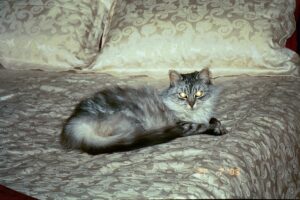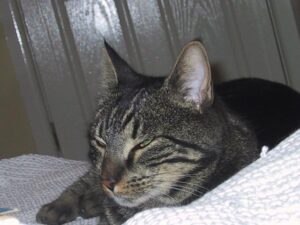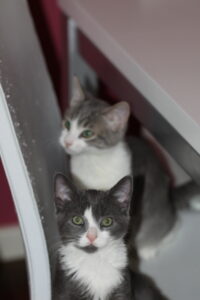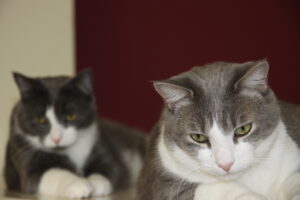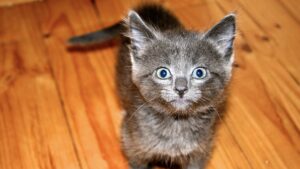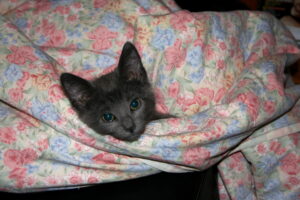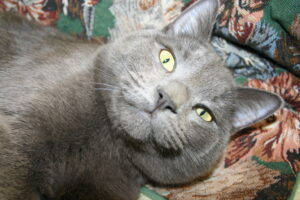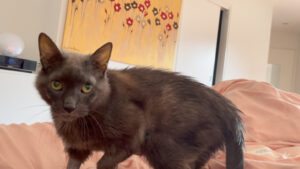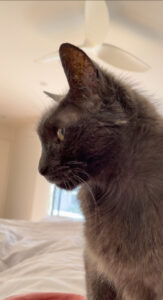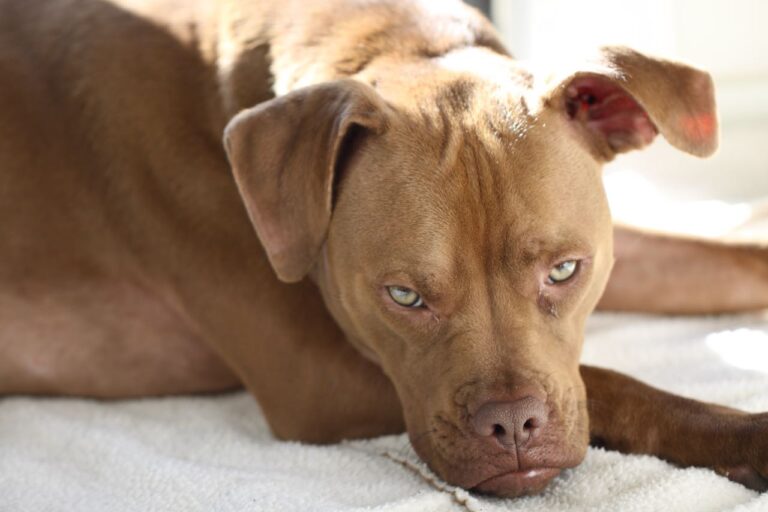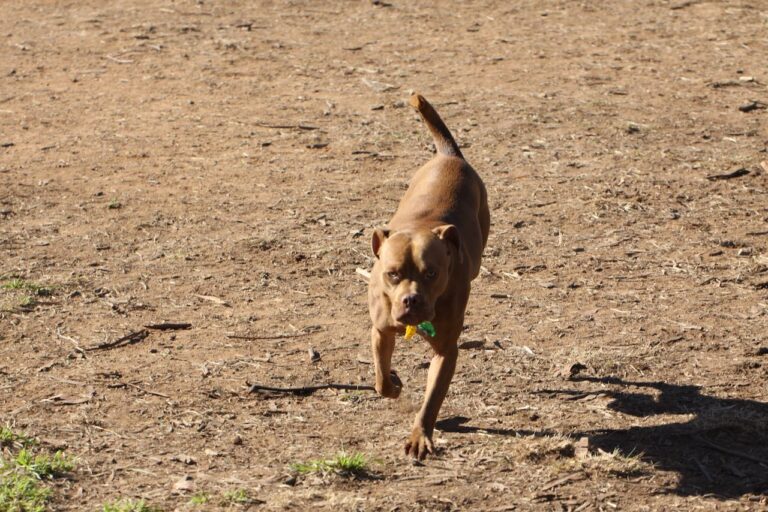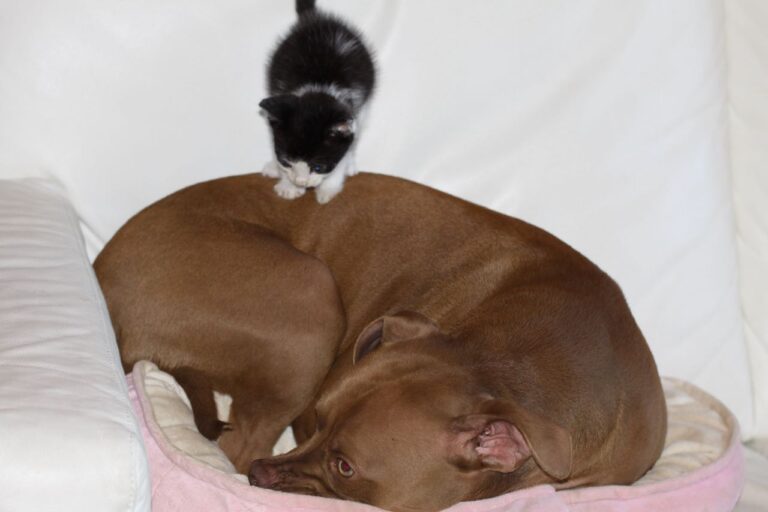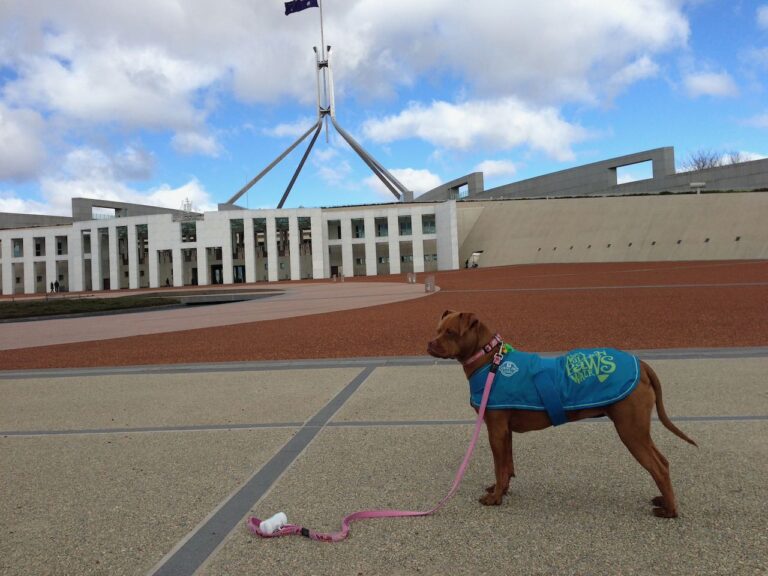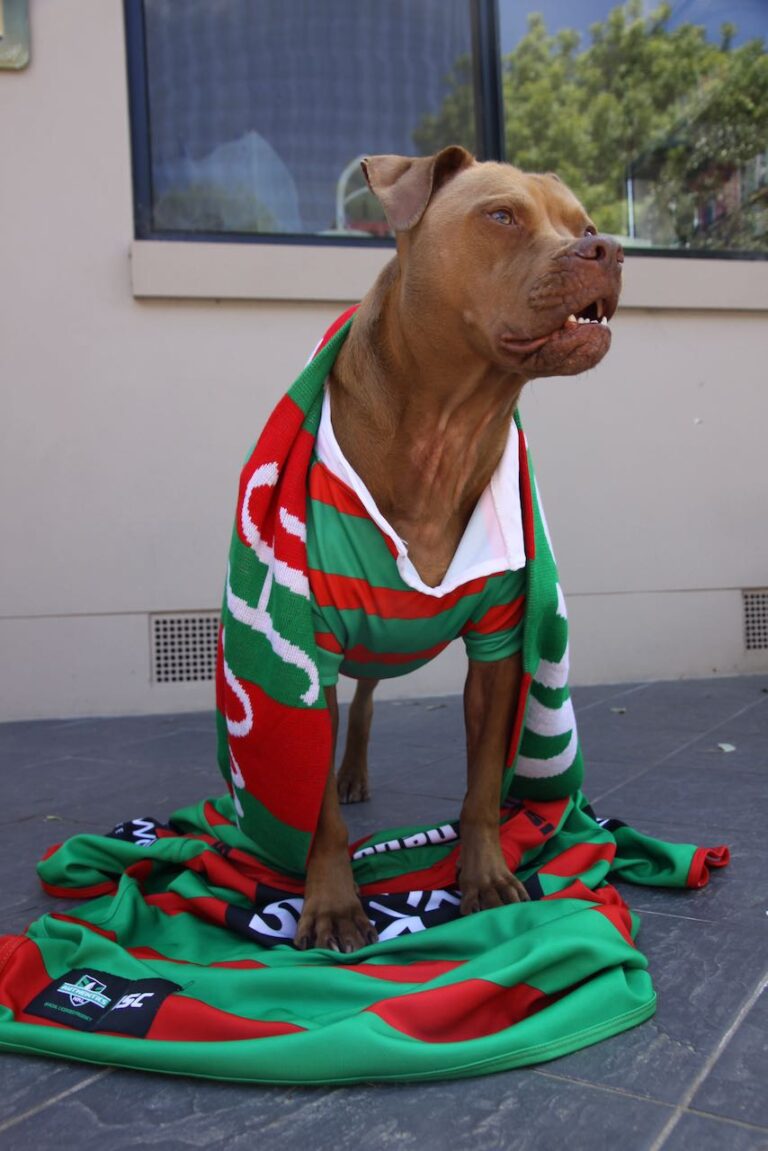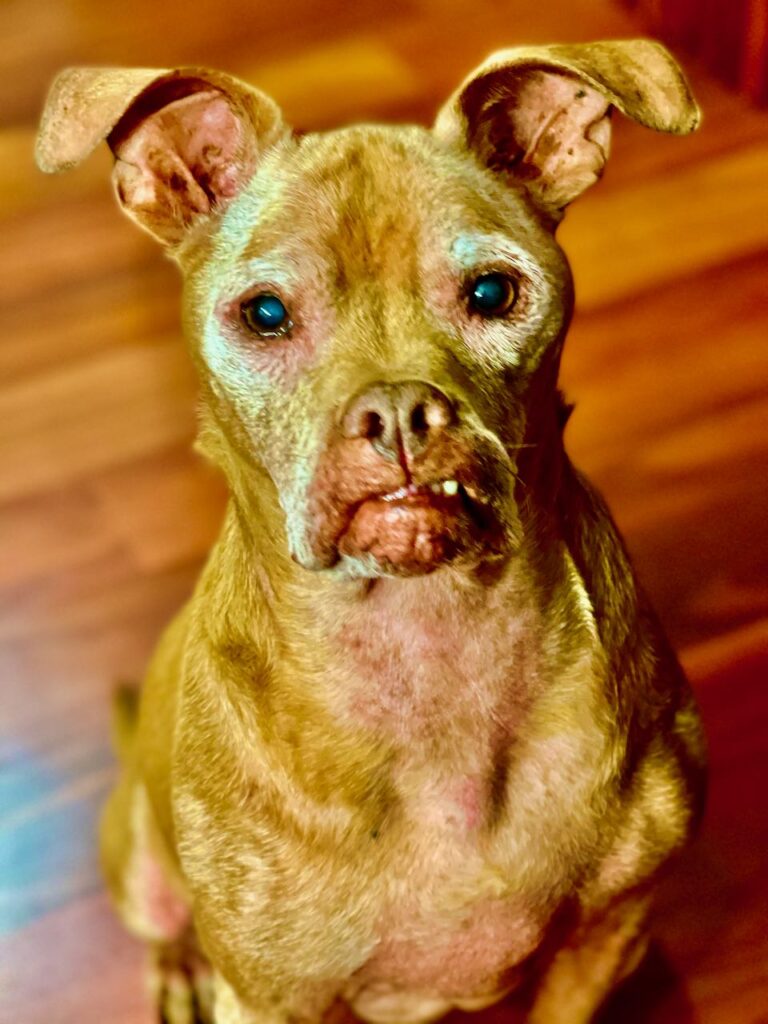In 2007 we bought a brand-new Audi A3. It took us about 10 minutes to make the decision. A few years later we adopted the most gorgeous red nosed pit bull that we’ve ever seen. But it took us about three weeks to make that decision. Normally Mardi and I are quite decisive, and we both know what we like. We both know what we want, we have shared values and are pretty aligned on most things, animal welfare being one of them. But adopting Dahlia was one of the toughest, and as it turned out, best, decisions were ever made. But first to our cats: possibly the biggest influencer on Dahlia!
When I met Mardi, in 1998, she had four cats. I hadn’t had a cat since I left home in 1986. It was sort of new to me, but I quickly got used to it, as they got used to me when I moved in in 1999. Our fur-kingdom grew over the next few years, where we hovered between seven and nine cats. This number exploding to the 20s when we were fostering for RSPCA. We built an expansive cat run and made changes inside to make our life, and of course theirs, more comfortable.

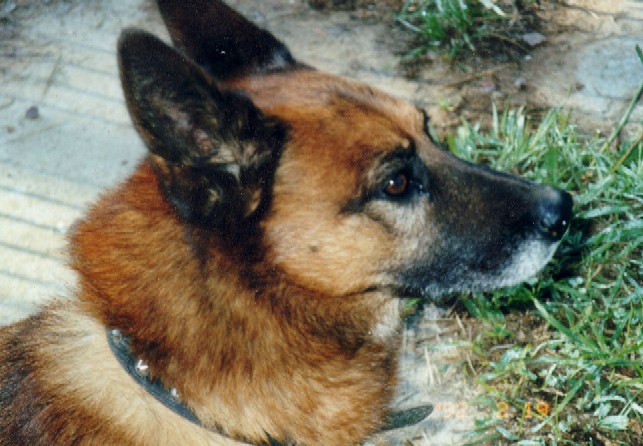
For a couple of years we also had Eddie, the wonder dog. Eddie was my Kelpie-Alsatian cross from my first marriage. I literally stole him back from my ex-wife, who was neglecting him. I jumped her fence in Penrith one day in 1999 and drove him back to Canberra with a couple of colleagues from the Tax Office. They were less worried about the theft of the dog and more worried about breaking Commonwealth Car use policies by having a dog in the car with us! Anyway we made it back to Canberra without incident.
Eddie was thin and nervous in his new surroundings. It was 2.00am when I got home and Mardi immediately cooked up some pasta for him and we gave him a good feed. We settled him down for the night and over the next few weeks brought him back to good health. He never got used to the cats, so he remained a largely outside dog. We walked him and enjoyed his company and played outside with him, but his best days were behind him. In 2001 another dog got into our backyard and mauled him. He lost an ear and was severely traumatised by the incident. He was never really the same after that. He’d spend his days lying in the sun, snoozing and exploring the backyard.
His back legs started to deteriorate as arthritis set in.
He died a few years later, 2002 aged 16, while we were renovating our house. A few days before he died he got out, the house was just a mess with no fences. We found him down the street curled up in the gutter. His hips and back legs had given way. We brought him back home in a wheelbarrow. The end was near for dear old Eddie. I had a conference to attend the next day, with the view to ending Eddie’s suffering when I returned in a day or so. He died that night in his sleep.
We had him buried in our courtyard and remembered him with a different coloured tile. Today a light shines into the sky where Eddie is buried. Eddie will always have a special place in my heart.
He found me. I was playing cricket in Newcastle in 1986, and while I was sitting on the ground having some lunch and drinking a lemonade, this little puppy wandered over and started to drink from my cup. He was thirsty and the sweet sticky drink must have been yummy for him. He had no collar. He hung around the cricketeers all afternoon. We playfully called hm Eddie. One of our team mates was named Eddie and some of us saw a likeness!
As we started to leave the cricket field, Eddie was following us around. I was the last to leave that day and Eddie cut a lonesome figure in the vast green expanse of the cricket field. His floppy ears and ungainly gait made him appear cartoon like in the late afternoon sun. We waited around for about an hour, hoping an owner might turn up as the light faded. No one could be seen. Eddie played with my legs, chased a cricket ball I was tossing around as I waited and basically said to me: “take me home”. After another hour I decided that was it, I couldn’t bear to leave this poor fella here on his own, so we took him home with us.
That was so long ago, but for 13 years h was with me all the way. He’d run beside my bike as I rode to cricket. He’d sit on the side line watching as I played and leapt for joy at the end of the day as we rode home together.
We had some great times together. I burst into tears when Mardi called me to let me know Eddie had died while I was away. Eddie was MY first pet dog. He was a constant with me as the world and my life changed during the 1990s. It was heart breaking to not be here when he died, but also comforting to know that that little puppy form all those years ago enjoyed such a rich life.
For a few years the cats had the run of the house. They enjoyed seeing foster kittens come and go. They enjoyed playing with them as the grew and we enjoyed the socialisation that these kittens got, meaning they were ideal for adoption.
A few months after Eddie died, we adopted Ellie. A stray kitten we found in Sydney while visiting Mardi’s mum. Shed be handed into a local vet clinic, covered in Weat-Bix and living in a box with her five brothers and sisters. We adopted her, cleaned her up and added her to our clan of four cats. For the next few years the five were our little fur kingdom.

Then five became six. Our newest arrival, Poppy, heralded from RSPCA where I started working in 2005. She joined us pretty soon after I started. I brought her home one weekend to look after and to give Mardi a pick me up (she’d been sick for a while). Poppy never went back and entered our lives, although she quickly became Mardi’s cat.
It was a love affair that lasted 18 years and recently we said good-bye to Poppy. She was a constant in our lives over this time: a few years ago she explored our bedroom for a couple of days and never left!
Her early life though was all fun and games. She’d play with the other cats, get mothered as a kitten and quickly grew into the queen of the household. She supervise foster kittens, helping socialise them and use our furniture as a parkour stadium. Her grey fur and gorgeous eyes ever present.
She had her fair share of vet visits: from an abscess as a four year old, inflicted by one of her brothers to long term medication as she aged dealing with arthritis, thyroid and blood pressure issues.
Poppy saw many other cats come and go during her 18 years. Maxie of old age, aged 17. Charlie and Maddie disappeared, before we built our cat run and Freddie as a four year old was hit by a car. Sasha and Ellie died from kidney disease at aged 18 and 13. Normie, died as a five year following a poor reaction to anaesthetic, Chrissie as a 12 year succumb to cancer on her face and ears. Midnight lost a battle with a large abdominal tumour at age 12 and Luigi, or Wigi, left us as an 11 year old following kidney failure.
We remember them all. They each have a little personality as unique as the next cat. From carrying toys around in their mouths, bringing leaves in from outside as rewards to sleeping in a specific spot and only that spot. Each imprints a little on us and reminds us how simple and carefree life can be sometimes and that while ever you have a cat in the house, your life never seems empty.
Poppy was survived by her brothers and sisters, Tommy a ten-year bug grey boy, Harry, another grey boy who is six. Sisters Willie and Hollie, aged eight. And our latest additions, Ricky, a black boy aged 2 and Chessie, aged six months, a Russian blue. All from the RSPCA. A nice little clan of furry goodness.
As you can see as animal lovers, we are always thinking about their welfare and we lived in a house run by cats. This was never more evident that when we thought about adopting a dog for the first time. That was 2007. This is Dahlia’s story.
Complicating things at the time was the fact that I was Chief Executive Officer at RSPCA. There was a lot of media scrutiny and I had a reasonably high profile. What did it say that the CEO had just adopted a specific type of dog? I had to be very careful and consider the implications of an adoption decision.
The scrutiny only grew when we settled on a little chubby female puppy named Dahlia.
You see, Dahlia was an American Pit Bull Terrier (APBT, aka pitty, pibble).
You know the line from the movie Jaws: “You yell barracuda, everybody says, ‘Huh? What?’ You yell shark, we’ve got a panic on our hands on the Fourth of July. “
Pit bulls have a reputation.
My personal belief is that it’s not warranted. There’s a lot of misinformation out there, like lock jaw; it isn’t a thing. Pitty’s are dog aggressive; false. Pitty’s aren’t good with cats: false.
Sadly though, the facts are that they are banned pretty much everywhere. Not Canberra, and just maybe, Dahlia had something to do with that…

Society has largely rejected them as a pet, and the expectation was that no good would come from me adopting a pit bull. I was warned by the board of directors, and I was warned by other CEOs not to adopt her. The chairwoman also sat me down and encouraged against it, she owned chihuahuas at the time (funnily enough they were more aggressive than Dahlia ever was).

I’m sure that the scrutiny added to our delayed decision. We took her home one weekend for a trial. She was all legs and arms, flailing everywhere running around in the backyard just enjoying life like any puppy should do. Not a care in the world.
Then we decided to introduce her to our cats. We had a dog cage (crate) inside. We placed Dahlia inside the crate and encourage the cats to come over and inspect. Cats are curious creatures, so they didn’t need much encouragement. Within a few minutes they were sniffing the cage. They were on top of the cage exploring as cats did. There was the occasional hiss and spit as they encountered Dahlia, who was as curious as they were. After a few minutes Dahlia simply sat there, even cowered at some points as the cat scrutiny increased. We left them to their own devices for a couple of hours. The cat curiosity levels waned, and Dahlia curled up for a sleep. We opened the door. Dahlia cautiously emerged, cats hunched their backs and puffed themselves up in a show of defiance and strength. Dahlia went to sniff a couple of cats, the odd swipe from a cat here and there saw her recoil and leave them be.
We the next few months we watched cautiously as our mixed house began to settle into a routine and before we knew it Dahlia in essence thought she was a cat. She’d curl up in a small cat bed, try to jump in my lap, try and stand on the window still. The cats became ambivalent, sometimes affectionate to Dahlia being around.
We socialised her, took her on long walks and to RSPCA events, morning brunch at Kingston was a treat for he which she loved as a puppy and young dog. She’d swim in the lake and we’d visit off lead dog parks.
It was at one of these off lead dog parks that we started to notice she was a little different to other dogs. Her first few visits, she ran with the pack. There would be a group of dogs running around chasing a ball, carrying a stick or whatever and she’d happily be part of that group. But by abut her fourth or fifth visit she became a loner. Wary of other dogs and largely staying with us, or at least in close proximity to us. She reminded us of that awkward kid at school in the playground standing on her own. She looked lost. At this time her favourite part was leaving the dog park for a ride in the car. So we stopped taking her.
We stuck to lake walks at Belconnen and the city as well as in our local area. From about 2009 to 20013 we woke literally every weekday morning at 5.00am and walked for an hour. She loved it and we got really fit! Rain, hail or shine, we’d be up walking. It was a great time for us: RSPCA was going really well, we had a brood of healthy animals and enjoyed taking some overseas holidays, with New York being a favourite destination. We started that love affair in 2010 and are making our tenth visit in 2023.
We had a few little incidents along the way. We were walking one day. I think it was Kingston Foreshore. A lady stopped us to chat about dogs, she had a five year old with her, her daughter we presumed. So as we are chatting the little girl is on her knees chatting away to Dahlia and patting her, looking her eye to eye, giggling away, they both seemed to be having a ball.
Then, the mother asked us, what type of dog Dahlia was.
“She is an American Pit Bull Terrier” I said.
“Oh really? Umm!” the mother said as she quickly leant down and picked up her daughter, shielding her form Dahlia, who simply sat there wondering where all the attention went. Some people!
That wasn’t the last time we had that reaction.
As news grew that I owned a pitty, so did the opportunities to educate and inform the general public. This was coupled with the work we were doing at RSPCA to change people minds about animal sheltering and the fact that you could, with effort, essentially home all healthy pets.
Dahlia and I appeared in newspapers and on TV talking about responsible pet ownership, fallacies about put bulls and animal welfare in general.
By 20012, we had attracted so much attention that the Sydney Morning Herald wanted to run a feature on Dahlia and pit bulls in general. Joel Meares was the reporter and he basically spent the day with us and at times, with Dahlia on his own. Below is the full transcript of that article.
Good Weekend, 12 February 2012: Pit bulls, click here for full article
Sydney Morning Herald – Good Weekend Magazine

25 February 2012, Author Joel Meares
American pit bull terriers have a nasty reputation as the canine world’s most vicious breed. But are these “time bombs on legs” really as bad as their critics say? Joel Meares (cautiously) investigates.
Harnessed at the end of her hot-pink leash, Princess Dahlia Dogwollop Linke is dragging me down Canberra’s Bunda Street. She skims the hot pavement with her chocolate-coloured nose as we plough through the pre-Christmas foot traffic, pausing to sniff the feet of shoppers refuelling at a crowded streetside cafe. When a beefy Harley-Davidson crackles past, she jerks hard towards the road, but I hold tight. Pushing on, I notice a young couple cross to the opposite side of the footpath. It’s a quick reminder that this princess is a pit bull.
A stroll through the city with two-year-old Dahlia is a Saturday routine for owners Michael and Mardi Linke. For me, it’s more social experiment. Dahlia is an American pit bull terrier (APBT) at a time when it’s tough to be an American pit bull terrier. Long feared as the most vicious of dangerous dogs –Time magazine dubbed them “time bombs on legs” – a pit bull-mastiff cross last year killed four-year-old Ayen Chol in north-west Melbourne, sparking fresh hatred of the breed. The government clamped down, newspapers recycled “killer breed” headlines, and these “sharks on leashes”, as comedian Billy Connolly once called them, were back in the firing line.
There isn’t much that’s shark-like about Dahlia, though. Solid at 20 kilograms, with a short tan coat and yellow-green eyes, she might be scary if not for a jutting underbite that sets her expression to clownishly proud. On the street, she lights up kids’ eyes – one little girl tells another, “Look at the puppy, it’s so cute!” – but adults are less sure. In a car park elevator, a shopper presses her back to the wall, casting a cautious eye over Dahlia as we ascend. Rounding the corner from a side street, one young woman gasps and jumps out of our way.
Dahlia noses forward, oblivious. I, however, can’t help but feel I’ve done something wrong.
“It is as if the vicious hound of the Baskervilles that burst upon Sherlock Holmes out of the fog has returned to haunt the streets of America.”
Time, July 27, 1987
For the past three decades, APBTs have built a reputation as the canine world’s worst breed. According to legend, they are crazed and trap-mouthed beasts, bred for vicious combat, owned by thugs and set loose upon the suburbs of the Western world. The law has responded accordingly. Only in the ACT and the Northern Territory can Dahlia walk a street like Bunda unmuzzled. In other states, where pit bulls are “restricted”, they must be muzzled and leashed in public, neutered and, in some cases, cannot be bought, sold or rehomed. The goal? As former NSW premier Bob Carr once put it, “To breed these dogs out of existence.”
Public sympathy for the disappearing dog has never been easy to find, and the death of Ayen Chol made it near impossible. Following the August attack, Victoria’s Baillieu government increased penalties for owners whose dogs killed, expanded breed restrictions to all “pit bulls”, not just pure-bred APBTs, and cut short an amnesty period for owners to register their restricted-breed dogs. Unregistered pit bulls and crosses found thereafter would be destroyed.
But some people are asking whether the pit bull deserves its fierce reputation. Proud owners like Michael Linke, also head of the ACT RSPCA, say their pets have become scapegoats for a problem that is about all dogs, not just those that look like theirs. “It’s about being a responsible owner,” he says. “You recognise that pit bulls are strong, and Dahlia’s a strong dog. But there are a dozen breeds that are strong, and if they do bite you, they’re going to do some damage. All dogs have teeth.”
An afternoon with Dahlia shows it isn’t just the dogs facing scrutiny. Eyes that lock onto her with alarm seem to move their way up her leash. It’s a bad time to be pit bull in Australia and a bad time to own one.
Michael and Mardi Linke describe adopting Dahlia as the “biggest decision we’ve ever made”. Mardi, who also works at the RSPCA, spotted Dahlia playing in a yard at work shortly after she was surrendered with her brothers Stewie and Sméagol. When Mardi heard she was a pit bull, she had reservations. But they brought her home for a weekend among their nine cats and eventually decided to adopt. “I don’t know what it was, but I just couldn’t stop thinking about her,” says Mardi. Today, Dahlia happily roughhouses with grey tabbies Luigi and Normie.
The Linkes tell their story in the courtyard behind their home in Belconnen. With spectacles and ink-free arms, they’re not what you might expect of pit bull owners; and Dahlia, who has been known to dress in pink pyjamas and clumsily stalk along the top of the couch like Luigi and Normie, is no “typical” pit bull. She even has her own Facebook page, through which Michael pushes pro-animal causes to 700-plus “friends”.
Yet when we first meet, I’m nervous. Dahlia backs away when I enter the courtyard, her yellow eyes trained on me, growling softly. As I sit and chat with the Linkes, she ventures close enough to sniff my hand; after a while, I scratch the wrinkly skin under her neck. But like Mardi, I have initial reservations.
“Pit bull” technically refers to an APBT, but in general use, particularly in the US, the term is a catch-all that can bring in Staffordshire bull terriers, the bigger American Staffordshire terriers, and other “bully” cross-breed lookalikes. They date back to the 19th-century British sport of dog fighting, where bulldogs used in bull-baiting – in which dogs leapt up to latch onto a bull’s nose with their jaws – were bred with terriers to produce agile fighters to rip at each other in arenas like the Westminster Pit. The new dog eventually made it to the US, and in 1898 the United Kennel Club there began registering them as American pit bull terriers.
The dog’s reputation in the early 20th century differs starkly from its reputation today. Then, the pit bull was America’s family pet: president Theodore Roosevelt kept one in the White House and Helen Keller had one. The breed came to our own shores on the back of this goodwill – genetic tests suggest Dahlia’s forebears arrived about 112 years ago. But as the century wore on and images of urban dogfights and pit-bull-owning drug dealers proliferated alongside reports of vicious pit bull attacks, the breed saw its cachet slide. In 1989, the US Centre for Disease Control (CDC) reported that pit bulls were involved in nearly 42 per cent of American dog-related fatalities, where breed was reported, between 1979 and 1988 – three times the figure for German shepherds.
A new chapter in the dog’s history soon began. The UK outlawed the breed in 1991, the same year the Hawke government banned the importation of pit bulls and three other breeds after a fatal attack on a two-month-old baby north-west of Sydney. (The killer was a bull terrier cross.) Tougher breed-specific legislation (BSL) followed, and the pit bull found itself muzzled, desexed and housed in escape-proof enclosures – 1.8-metre fences, self-closing gates, often concrete floors. Hardening Victoria’s laws after Ayen Chol’s death, Agriculture Minister Peter Walsh echoed Carr’s words from earlier: “These types of dogs have lost their right to exist in Victoria.”
In her book The Pit Bull Placebo, the founder of America’s National Canine Research Council, Karen Delise, describes outrage over pit bulls as a “moral panic”, and one the world has seen before. During the mid-19th century, Americans feared the frothy-mouthed bloodhound, which had been trained to hunt down escaped slaves. In the early 1900s, wolfish German shepherds were canine fiends. (Their importation into Australia was banned from 1929 to 1974.) Dobermanns next emerged as villains as the world watched SS guards and their Dobermanns stalk across Europe. Then came Rottweilers and pit bulls.
Dogs often earn their reputations because of the people who own them – Dobermanns are associated with Nazis, purse-size Chihuahuas with socialites. James Serpell, a professor of animal welfare at the University of Pennsylvania, says the pit bull’s status as a “bad breed” comes from its association with the now illegal world of dog fighting. “The possession of a large, powerful and potentially dangerous dog is clearly a badge of status among members of this criminal class, and the dog is therefore viewed as guilty by association,” says Serpell.
Whether based on panic or not, there is compelling evidence that breed-specific legislation does not work. The attack on Ayen Chol happened with BSL in place and similar legislation has been repealed in the Netherlands and Italy.
More fundamentally, claim BSL’s opponents, our current bad breed has been miscast as a villain. The pit bull has no “locking” mechanism in its jaw, a charge that has gained traction in the media since the 1980s. As a former bull-baiter, it has been bred to bite, hold and shake, and scientists I speak to say they have observed the breed to be impulsive. But studies have concluded that there is nothing unique in its jaw structure. Comprehensive records are not kept of dog bites in Australia, and doubters say damning statistics like the CDC’s rely heavily on newspaper reports and hospital records that often misstate breed. Meanwhile, less damning figures go mostly ignored. According to Monash University statistician Linda Watson, a fierce opponent of BSL, just two of the dogs involved in the 33 Australia dog-related fatalities she has counted since 1979 could be described as pit bull crosses.
James Serpell, who directs the University of Pennsylvania’s Centre for the Interaction of Animals and Society, surveyed 5000-plus dog owners for a 2008 report on canine aggression that delivered surprising results. He found that while pit bulls were among the most aggressive breeds towards other dogs, they were no more aggressive than other breeds when it came to people; Chihuahuas scored higher. “It has not been selected to attack people,” he says. “What it has been historically selected to do is to fight other dogs.” Serpell has had first-hand experience. Pit bulls have attacked his own lurcher four times in Philadelphia and his dog is now “something of a racist – he recognises pit bulls from a distance and will stop and ask to cross the road”. But Serpell remains open. “There’s so much variation within a breed. There’s going to be plenty of dogs within a sample that aren’t at all aggressive towards other dogs and make wonderful pets.”
The problem for BSL’s opponents is that no amount of research can compete with the raw shock of tragedy. And Ayen Chol’s death last August was the kind of tragedy that called for bloody vengeance: unprovoked, a neighbour’s dog chased Ayen’s cousin into the St Albans house where the Chol family was staying, turned on the four-year-old as she clung to her mother, and charged at her neck. She died quickly and violently.
Ayen’s maternal grandmother had not met Ayen before the girl was killed, and her health deteriorated when she heard the news, so the Chols were with family in Sudan as Good Weekend reported this story. In lieu of meeting with the family, I meet their lawyer, Ike Nwokolo, who raised $13,000 for the Sudan trip by running the Melbourne marathon last October. Sitting in one of legal firm Slater & Gordon’s sleek meeting rooms, Nwokolo says, “This is the most horrific case I’ve had to deal with in 17 years at the firm.”
He tells me he disagrees with those who say the pit bull has been harshly judged. “I don’t know that they have a greater propensity to attack. But I don’t think it’s a coincidence that most of the 10 dog-attack cases I’ve dealt with have been pit bull cases.” And he says the family is happy with the government’s response. “They see it as going some way to ensuring what’s happened to them won’t happen to anyone else.”
Mostly, though, we talk about why Ayen’s death hit such a public nerve – why a portrait of a blankly staring girl in a tartan top, the glint of a stud in her tiny left ear, would dominate Melbourne’s papers and TV news for weeks. “It affected most people who had children – someone is in their home and a dog rushes in and kills their child,” says Nwokolo. “It struck a chord with me because I have a four-year-old daughter, the same age as Ayen when she died.”
Discussing the attack in his courtyard, with Dahlia resting against my foot, Michael Linke says he was similarly moved by Ayen’s death, and that the case has had an impact he’s never seen before. “It’s not the first time a pit bull’s attacked somebody and it’s not the first fatality,” he says. “But it was like the stock market. You could map that event on a timeline as the one that shifted the whole psyche of people around pit bull terriers.”
Emotions are running higher than ever on both sides. Those who oppose BSL describe it as “genocide” and compare it to apartheid. Their numbers are significant – the Facebook page “Help Save the Pitbulls in Australia” has almost 5000 “likes” – and the rhetoric is strong. Meanwhile, Agriculture Minister Walsh says the public has reacted positively to Victoria’s crackdown – a “dob in a dangerous dog” hotline had attracted nearly 1200 calls by mid-December – and supporters ask how anyone can put the lives of animals before humans.
Having a pit bull in this climate is something you only confess to when asked. At least, that’s how I feel when answering the “What is she?” question with Dahlia. On a small crescent of beach along Canberra’s Lake Ginninderra, a dog owner asks me what breed Dahlia is as she splashes in the water with the woman’s cattle dog and Jack Russell terrier. “She’s a pit bull, actually,” I answer almost apologetically. “Oh?” she says, watching the dogs play. “She’s a nice, quiet one.”
In Melbourne, people don’t get close enough to ask. That’s the experience of 28-year-old policewoman Sarah, who meets me at her friend’s home east of the city and asks that I not reveal her real name, or her dog’s, for fear that it will be “baited”. Her registered seven-year-old black pit bull, Maple, is hardly frightening – splashes of white across her four paws make her look like a gloved dandy as she begs for a sausage. But muzzled on the street, she intimidates. “I was jogging with her not far from my house and we were approaching a lady with two little white fluffy dogs,” says Sarah. “Spotting us, the lady stopped, scooped her white fluffies under her arms and bolted like I’ve never seen someone bolt.” Other times, parents pull their kids behind them as she passes. “I am used to everybody staring because I’m always in uniform, but it feels uncomfortable when people are avoiding you.”
Sarah is also a qualified dog trainer. So it’s unsurprising that Maple is perfectly behaved – she begs, sits and licks me to say “hi”. Jumping onto my lap, wet after a short swim, she’s almost too friendly. But Sarah worries that because she adheres to the letter of the breed-specific law, there’s a chance Maple could behave unpredictably. The dog has never run off-lead at a park nor socialised normally with people. Without knowing how Maple behaves unleashed and unmuzzled, Sarah says, “I honestly couldn’t say what Maple would be like if she were to get out and people were trying to catch her.”
Tammie King, who is developing a behavioural test for amicability in dogs at Monash University, shares that concern. She says the net impact of legislation that isolates “dangerous dogs” is that it could become a self-fulfilling prophecy. “If you’re imposing restrictions based on appearance, people aren’t going to be forthcoming in letting their children come up to a dog. That dog doesn’t then get adequate socialisation with children, which is important if they’re going to be safe with them.”
It is not just the pit bull feeling the pinch. The breed has few clear genetic markers – it was bred in the pursuit of a warrior, not a show-perfect pedigree – and physically, it is almost indistinguishable from the American Staffordshire terrier and other stocky cross-breeds. Most governments use a list of physical indicators known as a “standard” to determine whether a dog is a pit bull or close enough to be restricted. But critics say the standard is hazy enough to pull in “innocents”. Owners have successfully appealed against declarations of breed based on standards in the past. The most famous of these appeals in Australia is the 2005-06 case of “Rusty”. The supposed pit bull from south-east Queensland spent 14 months in council custody before his owner proved he was a Staffordshire terrier cross.
A similar case kicked off last December at the Victorian Civil and Administrative Tribunal – expected to be the first of many. Shire officers had seized Tracy Ricardo’s two-year-old dog and puppy in October. Ricardo was at the VCAT claiming that her unregistered dogs were not pit bulls. As a mediation date was set, she sat at the back of the hearing room, wiping away tears. Afterwards, she shows me a folder with photos of her two young children sleeping next to the dogs. “They will have had no access to us for five months,” she says, flicking through the pages.
Breed confusion is mediated less formally in the suburbs. Patrick and Kelly Glennon live in a modest brick home in the shadow of the Dandenongs with their new daughter, Bridie, and three-year-old Staffordshire terrier, Dexter. They say they’ve seen a change in the way people respond to their dog since Ayen Chol’s death. They’ve stopped taking Dexter to cafes because of the “sighs and looks”. Kelly, 29, has watched a mother rush her kids into the car as she and Dexter approached. And when Patrick asked a woman at his local park to put her two Jack Russell terriers on a lead, she responded, “Don’t worry about my dogs, worry about yours.” He asked what his dog had done and she replied, “That’s the one that kills babies.”
Of the dogs I meet for this story, Dexter looks the most like Time‘s terrifying hound, despite not being a pit bull. He’s a loveable sloth inside the Glennons’ home, curled quietly in a dog bed as his owners talk, but later, at the local park, he’s a brindle blur sprinting after a ball and leaping into the air with teeth bared. There’s amazing strength in his brick-like legs and bullish face, and when he woofs loudly, I begin to wonder how close I’d get with my silky terrier. Electrician Patrick, 30, also looks the most like a bloke who might get about with a pit bull – 196 centimetres tall, tattooed, and every bit as brick-like as his dog. “I feel that some people look at us and say, ‘Nah,’ ” says Patrick, showing me a forearm with the word “Bridie” inked along it. “We’re a package, me and Dex.” Just as Dexter’s a Staffie, Pat’s a softie.
The Glennons say they’re comfortable having Dexter around Bridie, who was born three months premature and suffers from chronic lung disease. (There is a sign on the front door instructing people to disinfect their hands as they enter the home, but no “Beware of the Dog” sign next to it.) In the five months that Bridie was in hospital after her birth, Kelly would bring home her used blankets to introduce Dexter to her scent. In the living room when we meet, Pat holds Bridie upright and tells the dog to give the little girl a kiss – Dexter approaches slowly and licks her cheek. “It’s upsetting that we can’t take him places,” says Kelly. “He’s part of our family. That’s exactly how we see him. He’s Bridie’s hairy little brother.”
Hearing that, I can’t help but wonder why anyone would choose to have a dog who evokes the kind of response these breeds do? Why not cut your losses and buy a more socially acceptable Labrador? Academics say bull breeds can make wonderful pets because of their breeding – fighting dogs were always very close to their handlers. And there’s a case to be made for anthropomorphic appeal. Serpell points to their short fur, expressive eyes and “rather humanoid” look. Despite pictures you might see in papers, pit bulls can be cute.
Patrick says he’s always been interested in more active dogs. “A lot of it for me is the fact that I am six-foot-five and weigh over 100 kilos. I need something that’s a little more sturdy.”
But policewoman Sarah’s reasons are different. As a teen, she says she was too scared to even approach dogs in the street. But the pit bull won her over with an aspect of its personality you seldom read about. At home, her muzzle off and leash hung up, Maple will run through the lounge room, tuck her head and somersault. “She does it because I laugh – she’s very much a clown.”
Dahlia, it turns out, is also a bit of a clown. Back at the Linkes’ house after a splash in the lake, she’s refusing to say goodbye, and I’m beginning to think we’re back to where we started. But as I’m saying my farewells to her owners on their white leather lounge, Dahlia suddenly leaps onto my lap, curls her neck into me and squirms her thick body about.
I smile, and I think she does, too.
It’s amazing what a single dog can make you think about an entire breed.
Joel did such a good job on this article that the ACT continues to not have BSL and dogs like Dahlia form part of the fabric of our society.
During the next few years Dahlia’s health waxed and waned. From ongoing skin irritation issues to irritable bowel syndrome. Add in an inability to absorb protein, the building block of life, and Dahlia had a tough ten years. We would have easily seen a vet on average of once a month. This included specialists in Sydney and Canberra as well as her usual vet at Belconnen.
In early 2014 we thought we were going to lose her. She presented with paralysis is her hind quarters. She couldn’t toilet on her own nor walk. We were travelling with family as we left her with the vet, expecting to have to put her to sleep in a couple of days time. To our astonishment she came good.
That was Dahlia, for the next ten years we thought we had lost her and she would just recover.
One diet she had (kangaroo) caused massive malnutrition, and we almost lost her but we found a replacement, crocodile and spent hours driving around Canberra’s pet stores buying up all of this specific brand of food with crocodile in it. She recovered.
Then we thought she had cancer and had to have major surgery. Nope, she was fine after the vet removed a couple of benign lumps and within a couple of days she was back to her uncoordinated dopey self.
This is how it went on for ten years. She go down hill and we’d prepare for the worst.

But this day in July 2023 there would be no coming back. Over the course of a month or so her back end went on her again. She was falling down steps, falling over simply walking around and looked confused about where she was, often standing statue like in our courtyard for hours on end. Maybe she was too scared to move.
The last week or so saw me carrying her around to get her from bed to outside for a quick wee and stand in the sun. Id then carry her back into bed, where she would sleep peacefully.
Finally, we made the decision to let her go. For a couple of days she had hardly moved and she had stopped eating. It was time. She wasn’t going to miraculously bounce back this time. At 14 she had seen so much, met so many people, Prime Ministers, Governors General, Ita Butrose, Katy Gallagher, Wil Anderson, Billie Birmingham, The Raiders, The Brumbies, The Wallabies, The Wiggles and a clan of cats that loved her to the very end.

Rest in peace sweet Dahlia, you changed our lives and your legacy will live on as we continue to fight for pibbles.









